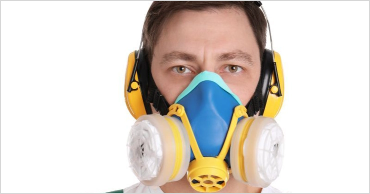
N95 respirator masks became a household name during the recent outbreak of COVID-19. However, despite their newfound fame, misconceptions about their protective capabilities still exist - shockingly, even among health workers. One particularly problematic myth concerning N95 masks in healthcare settings revolves around the belief that they can shield workers against harmful gases and vapors.
This belief has no grounding in reality. N95 masks are not designed to filter out chemical fumes and vapors that one may encounter in medical environments, such as hospitals, for example. Believing these masks can keep you safe in such situations can prove to be fatal.
Here’s the thing: as far as the efficacy of N95 masks is concerned, it lies in their ability to trap airborne particles. How do they manage to neutralize the threat of airborne particles? That’s simple. N95 masks contain a filtration system that is made up of tightly interlaced fibers. These fibers can intercept, impact, and diffuse particulate matter as air passes through them.
As a result, N95 masks end up filtering out about 95% of airborne particles that are as tiny as only 0.1 microns. That’s the reason why they were recommended against COVID-19. They can protect wearers - healthcare workers and commonfolk alike - against certain types of bacteria and airborne pathogens that have a size range of 0.3 to 20 microns. Fortunately, this also includes pathogens that cause tuberculosis.
Now, when it comes to gases and vapors, these two are made up of molecules that are even smaller. Think between 0.0003 and 0.006 microns. Their exceptionally minuscule size makes it easy for them to penetrate the layers and filtering fibers of a typical N95 mask. If you’re wondering which gases can pass through, examples include chlorine, ammonia, hydrogen sulfide, and oxygen. So if you try to use an N95 mask to protect yourself against these or similar chemical gases, you will derive no real benefit. Any perceived improvement will be purely psychological.
If you need to protect yourself from these toxic gases and their vapors, you need specialized equipment. Or rather, a specialized filtration method - namely, absorption and adsorption.
In the process of absorption, the gas concerned is absorbed into the internal structure of a substance such as activated charcoal, where it is retained within the molecular makeup of the latter.
As for adsorption, this involves binding the molecules of a toxic gas to the surface of another material through weak intermolecular forces or specific chemical interactions. This weakens the strength of the toxic gas.
That said, selecting the right respiratory protection for the hazardous airborne substances you are exposed to in your working environment will prove to be a highly technical task. The only way to be sure you end up with the right protection is to trust a certified industrial hygienist. Basically, someone who has a strong understanding of the toxicity of airborne agents, permissible exposure limits, and the performance capabilities of different respirator types.
If you’re an employer managing a team of workers who are regularly exposed to airborne hazards, it is mandatory as per OHSA - Occupational Safety and Health Administration - to provide your team with formal respiratory protection awareness training. Such a program should be developed and overseen by qualified personnel and should include hazard evaluation, selection of suitable respirators, medical evaluations, proper fit testing, and comprehensive training for workers.
Any and all chosen respiratory equipment must be especially customized to cater to the specific airborne threats and exposure levels present in your workplace. This shines light on the critical role an industrial hygienist plays, which can be compared to that of a medical professional. Just like medical professionals, industrial hygienists ensure that the correct "prescription" for respiratory safety is administered responsibly and effectively.

